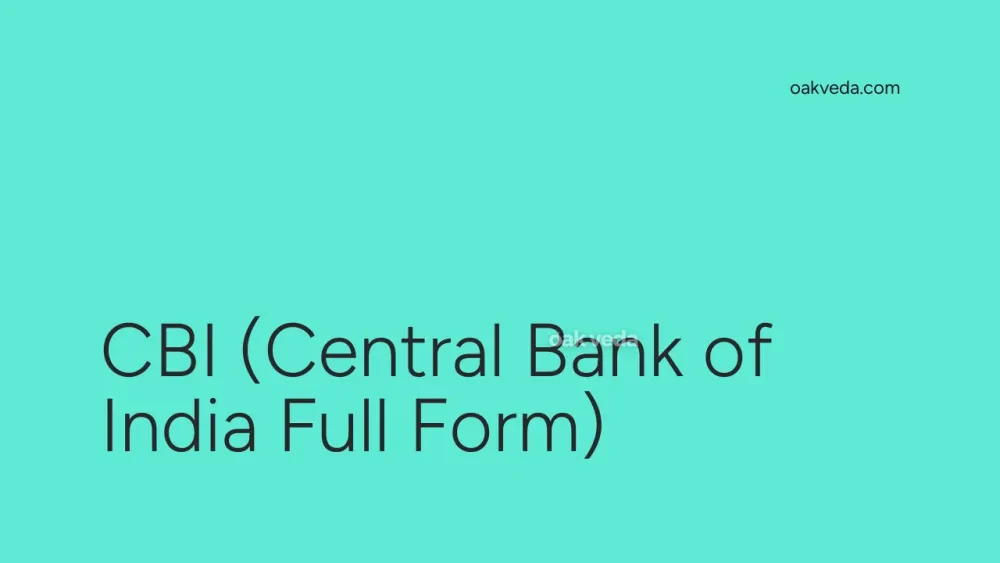
What is the Full Form of CBI?
The full form of CBI in the context of banking is Central Bank of India. It's important to note that CBI can also stand for Central Bureau of Investigation, which is India's premier investigating agency. However, this article focuses on the Central Bank of India, a major public sector bank in the country.
What is Central Bank of India?
Central Bank of India is one of India's oldest and largest commercial banks. Established in 1911, it holds the distinction of being the first Indian commercial bank that was completely owned and managed by Indians. The bank is headquartered in Mumbai, the financial capital of India, and plays a significant role in the country's banking sector.
Origin and Development of Central Bank of India
The Central Bank of India was founded on December 21, 1911, by Sir Sorabji Pochkhanawala, with Sir Pherozeshah Mehta as its first Chairman. The bank was established with the vision of promoting banking habits, thrift, and industry in India. Over the years, it has grown significantly and adapted to the changing financial landscape of the country.
How does Central Bank of India work?
As a public sector bank, Central Bank of India operates under the guidance of the Reserve Bank of India (RBI) and the Ministry of Finance. It offers a wide range of banking services to individuals, businesses, and government entities. The bank works on the principles of commercial banking while also focusing on financial inclusion and supporting the government's economic initiatives.
Functions of Central Bank of India
- Deposit Acceptance: The bank offers various deposit schemes, including savings accounts, current accounts, and fixed deposits.
- Lending: It provides loans to individuals, businesses, and industries.
- Digital Banking: CBI offers modern digital banking services, including mobile and internet banking.
- Foreign Exchange: The bank deals in foreign exchange and provides international banking services.
- Government Business: It acts as an agent for the government in various financial transactions.
- Financial Inclusion: CBI actively participates in government schemes to promote financial inclusion in rural and semi-urban areas.
Applications of Central Bank of India
Central Bank of India plays a crucial role in various sectors of the Indian economy:
- Agriculture: Provides loans and financial services to farmers and agri-businesses.
- Small and Medium Enterprises (SMEs): Offers specialized banking solutions for SMEs to support their growth.
- Corporate Banking: Caters to the financial needs of large corporations and institutions.
- Retail Banking: Provides a range of services to individual customers, including personal loans, home loans, and credit cards.
- Government Initiatives: Participates in implementing various government schemes and financial policies.
Features of Central Bank of India
- Extensive Network: As of March 31, 2023, CBI has a network of over 4,500 branches and more than 3,600 ATMs across India.
- Pan-India Presence: The bank has a presence in all 28 states and 8 union territories of India.
- Digital Banking: Offers advanced digital banking solutions, including mobile banking, internet banking, and UPI services.
- Diverse Product Portfolio: Provides a wide range of banking products and services catering to various customer segments.
- Financial Inclusion Focus: Actively participates in government initiatives to bring banking services to underserved areas.
Benefits of Central Bank of India
- Trusted Institution: With over a century of experience, CBI is a trusted name in Indian banking.
- Government Backing: As a public sector bank, it enjoys the backing of the Indian government.
- Wide Reach: Its extensive network ensures accessibility across the country.
- Competitive Rates: Offers competitive interest rates on deposits and loans.
- Financial Expertise: Provides expert financial advice and services to customers.
Limitations or Challenges of Central Bank of India
- Competition: Faces stiff competition from private sector banks and new-age fintech companies.
- Non-Performing Assets (NPAs): Like many public sector banks, CBI has faced challenges with NPAs.
- Technological Adaptation: Needs continuous investment in technology to keep up with rapidly evolving digital banking trends.
- Customer Service: Sometimes criticized for bureaucratic processes and slower service compared to private banks.
Future Developments in Central Bank of India
- Digital Transformation: Focusing on enhancing digital banking capabilities to improve customer experience.
- International Expansion: Seeking to expand its presence in international markets.
- Sustainable Banking: Increasing focus on green banking and sustainable finance initiatives.
- Collaboration with Fintech: Exploring partnerships with fintech companies to offer innovative financial solutions.
FAQs on CBI Full Form
-
Is Central Bank of India the same as the Reserve Bank of India? No, Central Bank of India is a commercial bank, while the Reserve Bank of India is the country's central bank and regulatory body.
-
When was Central Bank of India established? Central Bank of India was established on December 21, 1911.
-
Is Central Bank of India a government bank? Yes, Central Bank of India is a public sector bank, majority-owned by the Government of India.
-
Can NRIs open accounts in Central Bank of India? Yes, Central Bank of India offers NRI banking services, including various types of accounts for Non-Resident Indians.
-
Does Central Bank of India offer online banking services? Yes, Central Bank of India provides comprehensive online and mobile banking services to its customers.
In conclusion, the Central Bank of India, with its full form CBI, stands as a testament to India's banking heritage and continues to play a vital role in the country's financial landscape. As it navigates the challenges of modern banking, CBI remains committed to serving the diverse financial needs of the Indian population while adapting to technological advancements and global banking trends.
You may be interested in:
- ADCB (Abu Dhabi Commercial Bank): Full Form Explained
- ESIC (Employees' State Insurance Corporation)
- PSU (Public Sector Undertaking): Full Form Explained
- B.Com (Bachelor of Commerce): Full Form and Guide
- AMC (Annual Maintenance Contract): Full Form Explained
- CEO (Chief Executive Officer): Full Form and Role

